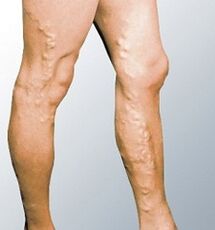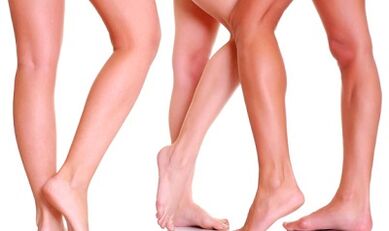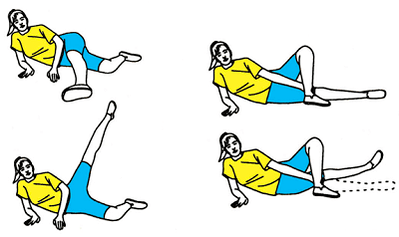
Varicosis is a chronic disease of the subcutaneous vein, where the venous valve function is inverted, as a result, blood vessels in the blood vessels, swelling and other effects.
Varicose development occurs in small pelvic veins, esophagus, stomach, in men - penis (varicocele), but in most cases the disease affects the feet, as they are vulnerable to the biggest load.
The movement of blood through the lower leg veins occurs at the bottom, contrary to gravity.Current - reflux - prevented by the vein valve.Due to the lack of valve, blood accumulates in the vessel and presses on the wall, stretching it.
Also, against the background of this process, the phenomenon of inflammation occurs.All of these are accompanied by symptoms of varicose veins:
- The winding of features and thickening of the foot vessels.
- Intensive pain and burning, especially with load.
- Fast fatigue, severity in the feet.
- Dark blue, redness of the lower leg vein, which can be clearly seen in the photo.
- Acquisition of brown pigmentation, shiny ankle, lower leg.
- Periodic seizures.
- Ulcer.
Any disease is better treated in the early stages, so it's important to know how varicose veins start.
Symptoms of the first stage of the disease are arranged in an increase in improvement:
- Swollen the night.
- After sitting or standing in the caviar, the sensation of breaking and severity appears to pass after a rest or walking.
- Night cramps in calves, heat in one or both feet.
- The manifestation of dark subcutaneous veins and the appearance of vascular "stars" below the knee, behind the lower leg.
Often, varicose veins are shown in people after 30-40 years, although it occurs in school children.According to various sources, every 10 man and every 3 -year -old woman suffer from her.
The reason for the development of this disease
- Predit of heredity: valve defects, their absence.
- Increases venous pressure:
- Large load on the feet, lifting weights (for example, involved in professional sports);
- a long standing work or a static position;
- Overweight;
- Pregnancy, hormone disorders.
- Age -related changes.
- Inactive lifestyle (for example, inactive work).
The final factor plays a major role, as not only heart contraction, but also muscle contraction -The leg contraction contributes to the movement of blood through the veins.
If you do not take any steps, varicose disease is complicated by eczema, thrombophlebitis, trophic ulcer (long injury) or varicose veins.
How to treat varicose veins in the feet?

In addition to visual medical examinations, to identify and evaluate varicose veins allow:
- reovasography;
- Ultrasound from the bottom of the foot;
- Phlebo.
How to treat varicose veins, the phlebologist determines based on the level of the disease, the age of the patient, the features of the health and condition.Overall, the choice is between conservative treatments and surgery.
In the absence of acute manifestations, the patient is characterized by varicose vein treatment, dietary nutrition, training, the use of elastic bandages and special knitwear for vein compression.Certain therapies and medicines are prescribed by your doctor.
Usually in the early stages, ointment is prescribed, which prevents trimination.Venotonizing agents - phlebotonics are commonly used from tablets.
Patients can be shown physiotherapy to improve blood flow, for example, pneumatic massage.Hirudotherapy is considered effective for the treatment of varicose veins, due to leech, blood sucking, releasing an enzyme that melts blood.
All conservative traditional methods are intended to maintain veins and improve the condition of the patient, but they do not cure varicose veins.Using surgery, you can remove the affected surface vessel and, if any, tumor, compress it.But the radical way to solve this problem is full of complications and has a long recovery period.
To date, the most progressive method has been considered:
- Cauterization veins with laser.
- Sclerotherapy (releases damaged veins from blood flow using special medical foam).
Because the disease often occurs during pregnancy, it is important for pregnant women to visit phlebologists regularly, especially if there are complaints.
Home treatment of varicose veins and folk remedies
It is possible to improve the condition of the veins in the legs and to relieve the symptoms of varicose development with the help of popular treatment.There are many ways for this.
Horse chestnut is the best remedy for varicose veins.Pour 50 g of flowers 0.5.L. alcohol or vodka.Let it plant for two weeks, and then strain and drink one tablespoon three times a day before eating.To avoid burning the throat, drink tincture with water.Within a week, interrupt for 14 days and go through another course.
You can apply Mokritsa leaves to the affected veins, and above - a burdock, cabbage or broken sheet.Place such compression four times daily for 30 minutes.every.The course is a few weeks with a two break.
Pour a dried cone with a glass of boiled water for 15 minutes.You need to take the infusion completely in 30 minutes.Before eating, and so on before receiving the results.The feet can be treated with the same tool using it as a compress.
No less than prolonged treatment - nettle dioecious.It should be mixed with boiling water and, after insisting, drink a quarter three times a day.
At night with varicose veins, at home, they make compresses made of natural oils and garlic chopped with husks.
Not just soothing varicose veins.Treatment with folk medicine must be supplemented by a diet where animal fat should be restricted in favor of vegetables, fruits and especially berries (the same diet is also indicated by thrombophlebitis).
Prevention and training for varicose

If you have a tendency for the disease, the following suggestions will help slow down its development:
- Do not stand and do not sit for a long time - move, knead, more often change your body position.
- Do not take a hot bath, especially in the morning - it is best to replace it with a warm bath with the final cold dile.
- Wear comfortable shoes without heels or low.
- In the case of a load, you can do a foot wrap or wear a therapeutic knit matter, but only after consulting a doctor.
- Reject smoking, where the blood vessels declined.
The main prevention of varicose veins is simple motor activity: swimming, walking, biking, charging.We recommend remembering warm exercises that will help keep the veins well.
- Stand straight, hands above the hips, slowly climb to your socks and fall on the feet 20 times, then repeat the same, just the heels together and the socks in different directions.After - walking on the socks.
- Stand right, your feet together, stretch your hands on inspiration, and on the exhale, return to its original position.Repeat several times, and then do the same, do a swallow at the first blowing with one foot, and then the other.
- Lie on your back and put your feet bent on your knees, on a chair and bend, straighten your feet alternately.
- Do "bike" exercises - it's very effective for varicose veins.
- Raise your foot up, and then become "birch" and slowly make scissors.
- Lying on your back, often pull your feet to your chest without holding your breath.
- Lying next to, bend the lower leg, and lift the top 20 times the cradle forward, up, then hold the upper leg and lift the lower leg.Do the same on the other side.

















